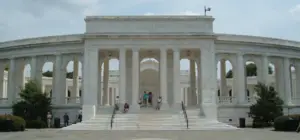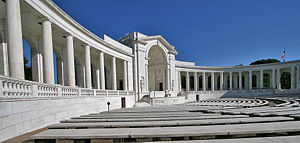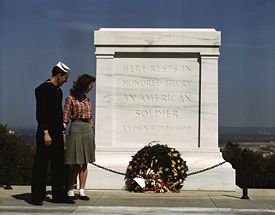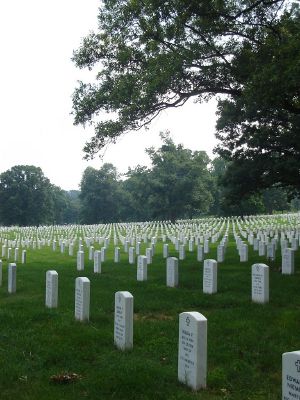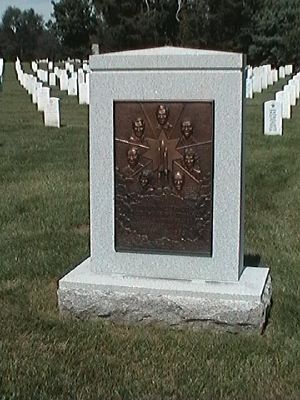Arlington National Cemetery
| Arlington National Cemetery | |
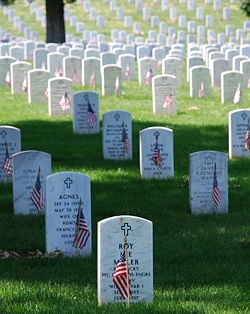 The gravestones at Arlington National Cemetery are graced by U.S. flags each Memorial Day. | |
| Cemetery Details | |
|---|---|
| Year established: | June 15, 1864 |
| Country: | United States |
| Location: | Arlington, Virginia |
| Coordinates: | Coordinates: |
| Type: | Public |
| Owned by: | United States Department of Veterans Affairs |
| Size: | 624 acres (3 km²)) |
| Number of gravesites: | 400,000+ (2012) |
| Website: | Official Site |
| Find A Grave: | Arlington National Cemetery |
Arlington National Cemetery is a United States National Cemetery located in Arlington, Virginia, near The Pentagon, and directly across the Potomac River from Washington, D.C. It was established during the American Civil War on the grounds of the antebellum plantation of George Washington Parke Custis, the adopted son of the nation's first president. The Arlington Mansion and 200 acres of ground immediately surrounding it were designated a military cemetery June 15, 1864, by the Lincoln Administration's Secretary of War Edwin M. Stanton.
Arlington remains an active military cemetery, averaging 5,400 funerals each year. More than 400,000 people have been laid to rest in an area covering 624 acres (2.53 km²). Veterans and military casualties from each of the nation's wars are interred in the cemetery, dating from the American Revolution. Pre-Civil War soldiers were re-interred at Arlington after 1900.
Arlington National Cemetery is administered by the Department of the Army. Arlington House, which is situated along the prominent ridges overlooking Washington, is operated by the National Park Service and serves as a memorial to Robert E. Lee. Arlington House was the pre-Civil War home of Lee and his wife, Mary Anna Custis Lee.
Nearly four million people visit Arlington National Cemetery annually. For some, it is a place to say a last farewell during funeral services for a friend or relative; for others, it is an opportunity to remember and honor the nation's war heroes; while for many the cemetery represents a chance to walk among headstones that chronicle American history.
History
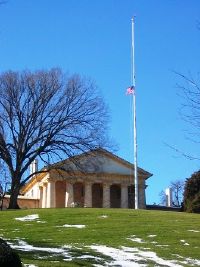

Arlington House is a nineteenth century mansion standing amid the more than 250,000 military gravesites that stretch out around it. When construction began on the mansion it was intended as a living memorial to George Washington, first President of the United State. It was built by Washington's adopted grandson, George Washington Parke Custis. Custis hired George Hadfield to design his estate. Hadfield was a British architect who had come to Washington in 1785 to help design and begin construction the U.S. Capitol. The Greek revival structure which Hadfield designed took 16 years to complete. The north wing was the first structure completed in 1802, the south wing in 1804. In 1818, the central section was completed, which connected the two wings. The exterior portico contains eight columns, each five feet in diameter at the base.
George Washington Parke Custis and his wife, Mary Lee Fitzhugh, lived in Arlington House for the rest of their lives and were buried together on the property after their deaths in 1857 and 1853, respectively. Their only child, Mary Anna Randolph Custis, married her childhood friend and distant cousin, Robert E. Lee, a graduate of the United States Military Academy at West Point. Lee and his wife lived at Arlington House until 1861.
Before the Civil War, Lee was a United States Army officer. When Fort Sumter was forced to surrender, President Abraham Lincoln offered Lee the command of the Federal army. Lee deferred the offer, waiting to see how Virginia would decide.
Virginia ratified an alliance with the Confederacy and seceded from the Union. When Virginia announced its secession, Lee resigned his commission and took command of the armed forces of the state of Virginia, and later became commander of the Army of Northern Virginia.[1] He quickly established himself as an able commander, defeating a series of Union generals, until his final defeat and surrender at Appomattox Court House.
Following the ratification of Virginia's secession, federal troops crossed the Potomac and, under Brig. Gen. Irvin McDowell, took up positions around Arlington House. Following the occupation, military installations were erected at several locations around the 1,100 acre estate, including Fort Whipple (now Fort Myer) and Fort McPherson (now Section 11 of the cemetery).
The property was confiscated by the federal government when property taxes levied against the Arlington estate were not paid in person by Mrs. Lee. The property was offered for public sale January 11, 1864, and was purchased by a tax commissioner for "government use, for war, military, charitable and educational purposes."
Arlington National Cemetery was established by Brig. Gen. Montgomery C. Meigs, who commanded the garrison at Arlington House, appropriated the grounds June 15, 1864, for use as a military cemetery. His intention was to render the house uninhabitable should the Lee family ever attempt to return. A stone and masonry burial vault in the rose garden, 20 feet wide and 10 feet deep, and containing the remains of 1800 Bull Run casualties, was among the first monuments to Union dead erected under Meigs' orders. Meigs himself was later buried within 100 yards of Arlington House with his wife, father and son; the final statement to his original order.
Lee deeply regretted the loss of his home at Arlington and continued to feel responsible for the estate. He earnestly hoped that the slaves who were left behind would be educated and freed, according to the provisions of Custis' will. The federal government dedicated a model community for freed slaves, Freedman's Village, near the current Memorial Amphitheater, on December 4, 1863. More than 1100 freed slaves were given land by the government, where they farmed and lived during and after the Civil War.
Neither Robert E. Lee, nor his wife, ever returned to Arlington House, nor did they ever attempt to publicly recover control of it. They were buried at Washington University (later renamed Washington and Lee University) where Lee had served as president. After Gen. Lee's death in 1870 his oldest son, Custis Lee, claimed that the land had been illegally confiscated and that, according to his grandfather's will, he was the legal owner. In December 1882, the U.S. Supreme Court, in a 5-4 decision, returned the property to Custis Lee, stating that it had been confiscated without due process.
On March 3, 1883, Congress purchased the property from Lee for $150,000. It became a military reservation, and Freedman's Village, but not the graves, was removed.
Features of the cemetery
Arlington Memorial Amphitheater
The Arlington Memorial Amphitheater, near the center of the Cemetery, is the home of the Tomb of the Unknowns. This site has also hosted the state funerals of many famous Americans, such as General of the Armies John J. "Black Jack" Pershing, General of the Air Force Henry H. "Hap" Arnold, the Unknown Soldiers, and five victims of the September 11 attacks, as well as annual Memorial Day and Veterans Day ceremonies. Every American President of the twentieth and twenty-first centuries has presided over holiday gatherings at this site.
Judge Ivory Kimball worked during several sessions of Congress as the department head of the Grand Army of the Republic in the District to get a bill through Congress to build the Amphitheatre. The bill finally went through during President Theodore Roosevelt's administration, when Congress authorized its construction March 4, 1913. Judge Kimball participated in the ground-breaking ceremony, March 1, 1915, but did not live to see his dream completed. President Woodrow Wilson placed its cornerstone October 15, 1915.
A colonnade of arched openings with attached Doric columns on the piers completely encloses the amphitheater. The architect was Thomas Hastings of the New York-based firm of Carrère and Hastings. The structure is mostly built of Imperial Danby marble from Vermont. The Memorial Display room, between the amphitheater and the Tomb of the Unknowns, uses Botticino stone, imported from Italy.
Before the Arlington Memorial Amphitheater was completed in 1921, important ceremonies were held at what is now known as the "Old Amphitheater." This structure sits where Robert E. Lee once had his gardens. The amphitheater was built in 1868 under the direction of General John A. Logan. Gen. James Garfield was the featured speaker at the Decoration Day dedication ceremony, May 30, 1868. The amphitheater has an encircling colonnade with a latticed roof that once supported a web of vines. The amphitheater has a marble dais, known as "the rostrum," which is inscribed with the U.S. national motto found on the Great Seal of the United States, E pluribus unum ("Out of many, one"). The amphitheater seats 1,500 people and has hosted speakers such as William Jennings Bryan.[2]
Tomb of the Unknowns
The Tomb of the Unknowns is a monument dedicated to American servicemen who have died without their remains being identified. The "Unknown Soldier" of the First World War is a recipient of the Medal of Honor, the Victoria Cross, and several other foreign nations' highest service awards. The U.S. Unknown Soldiers who were interred afterward are also recipients of the Medal of Honor, presented by the U.S. presidents who presided over their funerals.[3][4][5]
One of the more popular sites at the Cemetery, the tomb is made from Yule marble quarried in Colorado. It consists of seven pieces, with a total weight of 79 short tons (72 metric tons). The tomb was completed and opened to the public April 9, 1932, at a cost of $48,000.
It was initially named the "Tomb of the Unknown Soldier." Other unknown servicemen were later entombed there, and it became known as the "Tomb of the Unknowns," though it has never been officially named. The soldiers entombed there are:
- Unknown Soldier of World War I, interred November 11, 1921. President Warren G. Harding presided.
- Unknown Soldier of World War II, interred May 30, 1958. President Dwight D. Eisenhower presided.
- Unknown Soldier of the Korean War, also interred May 30, 1958. President Dwight Eisenhower presided again, Vice President Richard Nixon acted as next of kin.
- Unknown Soldier of the Vietnam War, interred May 28, 1984. President Ronald Reagan presided. The remains of the Vietnam Unknown were disinterred, under the authority of President Bill Clinton, on May 14, 1998, and were identified as those of Air Force 1st Lt. Michael J. Blassie, whose family had him reinterred near their home in St. Louis, Missouri. It has been determined that the crypt at the Tomb of the Unknowns that contained the remains of the Vietnam Unknown will remain empty. Because of advances in medical and other identification techniques, no further interments in the tomb are anticipated.
The Tomb of the Unknowns is perpetually guarded by the U.S. Army. The 3rd U.S. Infantry Regiment ("The Old Guard") began guarding the Tomb April 6, 1948.
Other notable sites

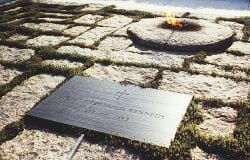
Two sites frequently visited are not on the cemetery grounds, but adjacent to it. They are the Marine Corps War Memorial (commonly known as the "Iwo Jima Memorial") and the Netherlands Carillon.
- The Marine Corps War Memorial is a military memorial statue dedicated to all personnel of the United States Marine Corps (USMC) who have died in the defense of their country since 1775. The design of the massive sculpture by Felix de Weldon was based on the iconic photo of the raising of the Flag on Iwo Jima by Associated Press photographer Joe Rosenthal.
- The Carillon was a gift from the people of the Netherlands to the people of the U.S. in 1954. The gift was made as a gesture of gratitude to the nation for its aid during and after World War II. The Carillon is surrounded by thousands of tulips.
- One of the most popular sites in the cemetery is the grave of President John F. Kennedy. He was interred at Arlington on November 25, 1963. On March 14, 1967, his body was moved to a permanent burial place and memorial. His wife, Jacqueline Kennedy Onassis, is buried with him, as are two of their infant children. His brother, Senator Robert F. Kennedy, assassinated in June 1968, is also buried nearby. President Kennedy's grave is marked with an eternal flame, while the Senator's is marked by an unadorned headstone and a simple cross. Kennedy and William Howard Taft are the only two U.S. Presidents buried at Arlington.
- Section 27 of the cemetery contains the graves of more than 3,800 former slaves, called "Contrabands" during the Civil War. Their headstones are designated with the word "Civilian" or "Citizen." There is also a Confederate section with graves of soldiers of the Confederate States of America and a Confederate Memorial.
- Near the Tomb of the Unknowns stands a memorial to the 266 men who lost their lives aboard the USS Maine, the sinking of which precipitated the Spanish-American War. The memorial is built around a mast salvaged from the Maine's wreckage. The Maine Memorial has served as the temporary resting place for foreign heads of state allied with the United States who died in exile in the U.S. during the Second World War, pending the return of their remains to their homeland. These were Manuel L. Quezon of the Philippines and Ignacy Jan Paderewski of Poland.
- The Space Shuttle Challenger Memorial was dedicated on May 20, 1986 in memory of the crew of flight STS-51-L, who died during launch on January 28, 1986. Transcribed on the back of the stone is the text of the John Gillespie Magee, Jr. poem entitled High Flight. Although many remains were identified and returned to the families for private burial, some were not, and were laid to rest under the marker. Two of the crew members, Dick Scobee and Michael J. Smith, are buried in Arlington. There is a similar memorial to those who died when the Shuttle Columbia broke apart during reentry on February 1, 2003, dedicated on the first anniversary of the disaster. Astronauts Laurel Clark, David Brown and Michael Anderson are buried in Arlington.
- On a knoll just south of Arlington House, with views of the Washington Monument and the Capitol, is a memorial to Pierre Charles L’Enfant, the architect who laid out the city of Washington. His remains lie below a marble memorial incised with his plan for the city. L'Enfant envisioned a grand neoclassical capital city for the young republic that would rival the capitals of European monarchies.
- The noted composer, arranger, trombonist, and Big Band leader Maj. Alton Glenn Miller of the U.S. Army Air Forces has been missing in action since December 15, 1944. Miller was eligible for a memorial headstone in Arlington National Cemetery as a service member who died on active duty whose remains were not recoverable. At his daughter's request, a stone was placed in Memorial Section H, Number 464-A in April 1992.
- There are only two mausoleums located within the confines of the Cemetery. One is for the family of General Nelson A. Miles, who served in the American Civil War, the Indian Wars, and the Spanish-American War. The other belongs to the family of General Thomas Crook Sullivan, a brigadier general in the U.S. Army who served in the American Civil War and was selected as a guard for president-elect Abraham Lincoln during his first inauguration.
- The Cross of Sacrifice or War Cross is the focal point of numerous war cemeteries throughout the world. It is a four point limestone Latin cross. On the face of the cross is a bronze sword, blade down. The only Cross of Sacrifice in the U.S. is in Arlington National Cemetery near the graves of U.S. citizens who enlisted in the Canadian military, and lost their lives during World War I. The memorial was proposed in 1925, by Canadian Prime Minister MacKenzie King. (Canada entered the war before the United States, and many Americans enlisted in Canada to join the fighting in Europe.) On June 12, 1925, President Calvin Coolidge approved the request, and on Armistice Day 1927, the monument near the Memorial Amphitheater was dedicated. The inscription on the cross reaffirms the sentiment expressed by Prime Minister King regarding Americans who served in the Canadian Forces. Following World War II and the Korean War, similar inscriptions on other faces of the monument were dedicated to the Americans who served in those conflicts.[6]
- The Women in Military Service for America Memorial is located at the Ceremonial Entrance to the cemetery and honors all women who have served in the United States Armed Forces. Planning for the memorial began in 1985, with the groundbreaking occurring ten years later on June 22, 1995. The Memorial was dedicated on October 18, 1997, and officially opened to the public on October 20, 1997. The Ceremonial Entrance was originally dedicated in 1932, when the Arlington Memorial Bridge opened, but was never actually completed or maintained. It was modified to include a reflecting pool, engraved glass panels on its roof and other changes. Inside is a museum area featuring exhibits on women in the military and military history, an education center and small theater.
- The Laos Memorial is a small memorial on the path between the JFK memorial and the Tomb of the Unknowns. It commemorates the veterans of the "Secret War" in Laos. Approved by the U.S. Department of Defense, but paid for by Hmong veterans, the memorial stands as a tribute to the Hmong, Lao, and other ethnic groups as well as the American advisers who made up the Secret War effort during the Vietnam War. The Laos Memorial was dedicated on May 15, 1997, in an emotional ceremony attended by thousands, including Hmong war veterans and refugees, American government officials, and U.S. supporters of the Hmong.
There are two memorials to those killed in separate acts of terrorist violence:
- The Pentagon memorial, which takes the shape of the Pentagon, is the memorial to the 184 victims of the terrorist attack on the Pentagon on September 11, 2001. The memorial lists the names of all the victims that were killed.
- The Lockerbie Memorial Cairn, which is the memorial to the 270 victims killed in the bombing of Pan Am Flight 103 over Lockerbie, Scotland on December 21, 1988. The memorial is composed of 270 stones, one for each person killed in the disaster (259 on the plane, 11 on the ground). Of the 270 people killed, 189 of them were Americans.
Notes
- ↑ Ezra Warner, Generals in Gray (Baton Rouge, 1959), 181.
- ↑ Arlington National Cemetery, Old Amphitheater. Retrieved January 15, 2009.
- ↑ C. Douglas Sterner, The Unknown Soldiers, Home of Heroes. Retrieved January 15, 2009.
- ↑ Arlington National Cemetery, Tomb of the Unknowns. Retrieved January 15, 2009.
- ↑ Medal of Honor, Congressional Medal of Honor Recipients—World War I Tomb of the Unknown Soldier. Retrieved January 15, 2009.
- ↑ Peters (1986).
ReferencesISBN links support NWE through referral fees
- Arlington National Cemetery. The Official Website of Arlington National Cemetery. Retrieved April 19, 2016.
- Atkinson, Rick. 2007. Where Valor Rests: Arlington National Cemetery. Washington, D.C.: National Geographic. ISBN 1426200897.
- Bigler, Philip. 1986. In Honored Glory: Arlington National Cemetery, the Final Post. Arlington, VA: Vandamere Press. ISBN 978-0918339058.
- Peters, James Edward. 1986. Arlington National Cemetery, Shrine to America's Heroes. Kensington, MD: Woodbine House. ISBN 978-0933149045.
External links
All links retrieved August 15, 2023.
- National Park Service site
- Official website of Arlington National Cemetery
- "Site Devoted To America's Most Hallowed Ground" Unofficial website of Arlington National Cemetery
- Arlington National Cemetery Plan your visit
Credits
New World Encyclopedia writers and editors rewrote and completed the Wikipedia article in accordance with New World Encyclopedia standards. This article abides by terms of the Creative Commons CC-by-sa 3.0 License (CC-by-sa), which may be used and disseminated with proper attribution. Credit is due under the terms of this license that can reference both the New World Encyclopedia contributors and the selfless volunteer contributors of the Wikimedia Foundation. To cite this article click here for a list of acceptable citing formats.The history of earlier contributions by wikipedians is accessible to researchers here:
- Arlington_National_Cemetery history
- Arlington_Memorial_Amphitheater history
- Women_in_Military_Service_for_America_Memorial history
The history of this article since it was imported to New World Encyclopedia:
Note: Some restrictions may apply to use of individual images which are separately licensed.

